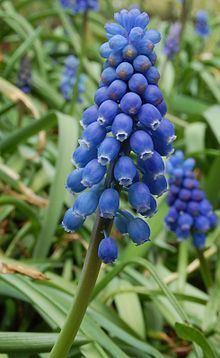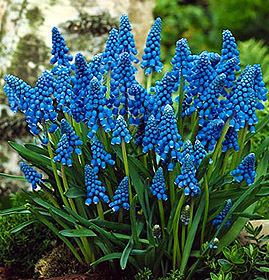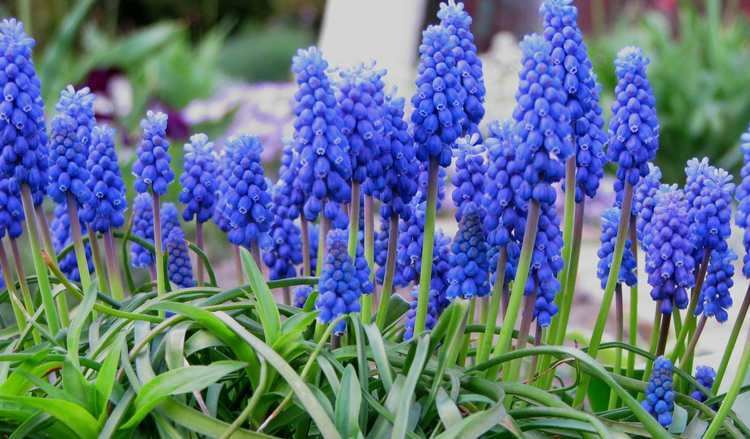Clade Monocots Scientific name Muscari Rank Genus | Clade Angiosperms | |
 | ||
Lower classifications Muscari botryoides, Muscari armeniacum, Leopoldia comosa, Muscari neglectum | ||
How to plant muscari gardening tutorial with jeff turner
Muscari is a genus of perennial bulbous plants native to Eurasia that produce spikes of dense, most commonly blue, urn-shaped flowers resembling bunches of grapes in the spring. The common name for the genus is grape hyacinth (a name which is also used for the related genera Leopoldia and Pseudomuscari, which were formerly included in Muscari). A number of species of Muscari are used as ornamental garden plants.
Contents
- How to plant muscari gardening tutorial with jeff turner
- Grape hyacinth muscari armeniacum how to grow grape hyacinth
- Description
- Taxonomy
- Species
- Species now allocated to other genera
- Cultivation
- Cultivars
- References
Grape hyacinth muscari armeniacum how to grow grape hyacinth
Description

The genus Muscari originated in the Old World, including the Mediterranean basin, central and southern Europe, northern Africa, western, central and south-western Asia. It has become naturalized elsewhere, including northern Europe and the United States.

Brian Mathew says that many species of grape hyacinths, including not only Muscari but also the related Leopoldia and Pseudomuscari, are difficult to distinguish. They usually have one or more narrow leaves which arise from a bulb. The flowers appear in the spring and form a spike or raceme, being held in a close or loose spiral around a central stalk. The flowers often become less tightly spaced as the flower matures. The flower colour varies from pale blue to a very dark blue, almost black in some cases (albino forms are also known). In some species the upper flowers may be of a different colour and shape to the lower flowers. Individual flowers are composed of six fused tepals forming a spherical to obovoid shape, constricted at the end to form a mouth around which the ends of the tepals show as small lobes or "teeth", which may be of a different colour to the rest of the tepal.
Taxonomy

The use of muscari as part of the name of at least some of the species included in the modern genus can be traced back to Carolus Clusius in 1601, long before the modern rules of botanical nomenclature were established. In 1753, Carl Linnaeus used the name Hyacinthus muscari for the plant now called Muscari racemosum. In 1754, Philip Miller formally established the genus Muscari according to modern rules of nomenclature. The name muscari comes from the Greek muschos, musk, referring to the scent.
Classified in the family Asparagaceae, subfamily Scilloideae, the genus was formerly placed in the Liliaceae as a member of the Hyacintheae tribe. There are about forty species. The genus was at one time divided into four groups or subgenera: Botryanthus, Pseudomuscari, Leopoldia and Muscarimia. Pseudomuscari and Leopoldia are now treated as separate genera. The genus Muscari is now more or less equivalent to the Botryanthus group.
A complication in splitting up the broad genus is that Miller's original Muscari included representatives of at least three of the new genera. Which one should retain the name Muscari would normally be decided by where the type species was placed; however Miller did not designate a type species, although the etymology of the genus name points to the species Linnaeus called Hyacinthus muscari (now Muscari racemosum).
The Muscarimia group are retained in Muscari by the Kew World Checklist of Selected Plant Families. Two species have been placed in this group: M. macrocarpum and M. racemosum (under the name M. muscarimi).
Species
As of November 2011, the World Checklist of Selected Plant Families accepts 42 species:
The names of some of the species are somewhat confused, especially in the horticultural literature. Thus the name M. racemosum is commonly found as an incorrect synonym for M. neglectum, with M. muscarimi or M. moschatum being used for the true M. racemosum.
Species now allocated to other genera
Cultivation
Some species are among the earliest garden flowers to bloom in the spring. They are planted as bulbs and tend to multiply quickly (naturalise) when planted in good soils. They prefer well drained sandy soil, that is acid to neutral and not too rich. Naturally found in woodlands or meadows, they are commonly cultivated in lawns, borders, rock gardens and containers. They require little feeding or watering in the summer, and sun or light shade.
